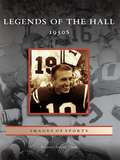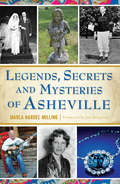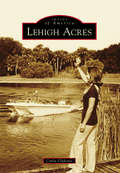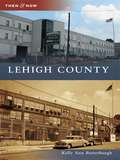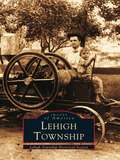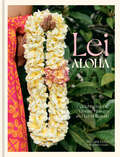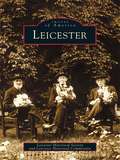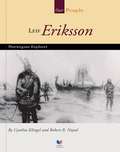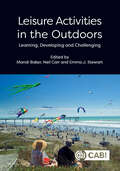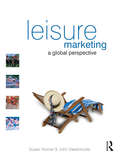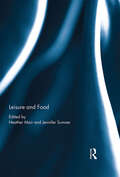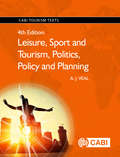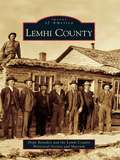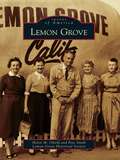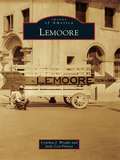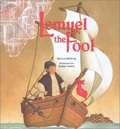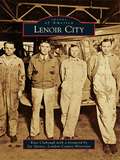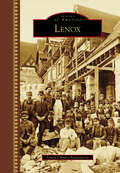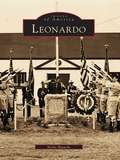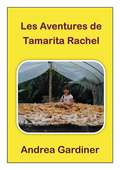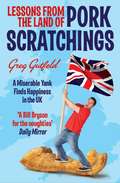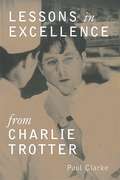- Table View
- List View
Legends of the Hall: 1950s (Images of Sports)
by Kristine Setting ClarkLegends of the Hall: 1950s captures a period of time when playing professional football was for tough, honest men who played solely for the love of the game. The 1950s was an era of crew cuts and nicknames like Crazylegs, Hopalong, and Night Train. The decade began with Sammy Baugh throwing his last passes and ended with the death of Bert Bell. This era also produced some of the greatest quarterbacks ever to play the game. They were known as the glamour boys of the league--Otto Graham, Bob Waterfield, Bobby Layne, Y. A. Tittle, and Bart Starr, to name a few. The incomparable, individual brilliance and unique team chemistry that marked this era have transcended this specific time and place to make Legends of the Hall: 1950s an unforgettable part of the magic and myth of professional football.
Legends, Secrets and Mysteries of Asheville
by Marla Hardee Milling Foreword By SchochetBeyond the beaten path of local landmarks, residents and tourists can find curious secrets, lost mysteries and fascinating legends. The famed Hope Diamond once found itself, and its mysterious curse, buried in an Asheville girl’s sandbox. Elvis once handed a cherished guitar to a local man at an Asheville concert, and he held on to it for forty years. At a flea market, an Asheville attorney paid a few bucks for an old tintype likely of Billy the Kid, and it may be worth millions. Native author Marla Hardee Milling recounts odd, but true, stories hiding behind Asheville’s picturesque beauty.
Lehigh Acres
by Carla UlakovicLehigh Acres emerged from an expanse of southwest Florida's wild lands due to the vision of industrialist, inventor, and self-made millionaire Leonard Lee Ratner and his business partners in the Lee County Land and Title Company. For Ratner, southwest Florida represented a land of opportunity. In 1952, he purchased Lucky Lee Ranch in eastern Lee County as a means to maintain his fortune; however, a chance meeting in Miami with Gerald Gould, a young advertising executive, forever changed the future of this Florida ranchland. They formed a company, began subdividing the land, and devised a marketing plan to attract buyers from the Midwest and Northeast by selling dreams in "a golden land of opportunity" and touting an average temperature of 74 degrees. Soon, roadways, model homes, the Lehigh Acres Country Club and Motel, and an ultramodern auditorium brought the community to life. As the decades moved on, the company's holdings grew to 60,000 acres, making Lehigh Acres one of the largest subdivided communities in the nation. Rich in natural beauty, amenities, and activities, the dynamic marketing team convincingly sold many on the idea "that you needn't be a millionaire to live like one" in Lehigh Acres.
Lehigh County (Then and Now)
by Kelly Ann ButterbaughLehigh County has transformed throughout the years and now is a far cry from its rural identity only 50 years ago. Today Lehigh County is known as an important link to the metropolitan areas of New York City and Philadelphia.
Lehigh Township (Images of America)
by Lehigh Township Historical SocietyLehigh Township was settled in the late 1700s by immigrants who had come to work in the numerous slate quarries. Situated in the foothills of the Blue Mountains, the township represented the last signs of civilization for those traveling north from Philadelphia to the wilderness beyond the Lehigh Gap. The township has remained largely rural, with farms and open fields abundant along its two-lane highways.Compiled by members and friends of the Lehigh Township Historical Society, Lehigh Township is a collection of rare vintage photographs of the community. The Cherryville Hotel (which in its heyday was known throughout the area as one of the best places to get Pennsylvania Dutch food), local quarries, one-room schoolhouses, Dieter's Foundry, and the Indian Trail and Edgemont amusement parks make up a sampling of the countless familiar images of Lehigh Township's past. Lehigh Township is an indispensable reference for both residents and visitors.
Lei Aloha: Celebrating the Vibrant Flowers and Lei of Hawai'i
by Meleana EstesExplore Hawaiian culture through the art of lei making with flower inspirations and gorgeous photography from stylist, fashion designer, and local island icon Meleana Estes.Brimming with vibrant photos of the most famous flower garlands of Hawai&’i—the lei—in dreamy island settings, Lei Aloha tells the story of the flowers, craftsmanship, and community of lei culture, offering a window into this beautiful world where life is a little slower, flowers are abundant, and personal connections run deep. Local style icon Meleana Estes continues the legacy of her native Hawaiian grandmother, who was well known for her intricate and stunning lei. Sprinkled throughout the book also are anecdotes about the fascinating history of flowers, lei, and island traditions.Each chapter tells the story of a grouping of flowers and lei, such as plumerias for a sweet gathering of neighborhood keiki (kids), elegant strands of white and yellow ginger for a candle-lit party, or striking lei haku made for hula performances. It&’s an easy craft for the homesteader with roots in a full backyard garden or the digital nomad who keeps her possessions in one suitcase and can pick up flowers on her travels. With evocative photos of vintage mu&’umu&’us, lush tropical gardens, lei-bedecked longboard surfers, striking tablescapes, and graceful hula dancers, Lei Aloha shares a side of the islands that only locals usually get to see.
Leicester
by Leicester Historical Society Leicester Historical CommissionLeicester began as a small Colonial settlement in the early 1700s and quickly blossomed into a flourishing farming community. Located among the headwaters of the Blackstone River, the numerous villages of Leicester prospered during the Industrial Revolution with gristmills, sawmills, and textile mills. By the 1880s, one-third of all hand and machine cards made in North America were produced in Leicester. After the deindustrialization of the twentieth century, the town began to return to its agricultural roots; today, for the most part, it appears largely rural once again. Leicester pays tribute to the industrial, yet rural, and independent, yet cooperative, spirit of this suburb of Worcester.
Leif Eriksson: Norwegian Explorer
by Cynthia Klingel Robert B. Noyed Cynthia Fitterer KlingelA biography of Leif Eriksson: Norwegian Explorer
Leif The Lucky
by Ingri Daulaire Edgar P. DaulaireA biography of Leif Erickson, son of Eric the Red,a famous Viking and early visitor to North America.
Leisure Activities in the Outdoors: Learning, Developing and Challenging
by Mandi Baker, Neil Carr, Emma J. StewartThe benefits of being outdoors in a leisure context are widely acknowledged across a range of disciplinary perspectives (including tourism, therapeutics, education and recreation). These benefits include the development of: health and wellbeing; social skills; leadership and facilitation skills; personal, emotional and reflective abilities; confidence and identity creation. Drawing on a variety of perspectives, geographies and approaches, this book explores the opportunities that leisure in the outdoors provides for learning, developing and challenging. The authors in this collection challenge dominant discourses of outdoor leisure through their selection of outdoor activities, theoretical approaches and modes of representation. All offer fresh insights and thinking into how leisure in the outdoors can be understood. The book covers a range of outdoor conceptualisations that challenge the reader to think deeply and broadly about the common threads which bind the broad field of outdoor leisure together. The experiences explored in this book range from suburban outdoors to wild places, surfing to mindful reflection, and trail walking to Nordic skiing, and encompass a broad spectrum of people. This book will appeal to outdoor scholars from a variety of contexts, including recreation, tourism, and adventure. It provides: ·original and leading research across layers of meaning attributed to and drawn from leisure experiences in the outdoors; ·value in theorising the notions of outdoor experiences; ·a variety and scope of contexts and approaches for students to draw on when learning about the field of outdoor leisure.
Leisure Marketing
by John Swarbrooke Susan HornerDivided into nine parts, Leisure Marketing: a global perspective guides the reader through leisure and marketing concepts, the marketing mix, key issues in different sectors, topical issues (such as globalisation, marketing research and ethics, for example branding and environmental issues), and the future of leisure marketing. A section of the book is devoted entirely to international case studies, which illustrate and highlight key themes and issues raised throughout in order to facilitate learning. Example of international cases used are: Disneyland Resort, Paris: The Marketing Mix Manchester United Football Club: Marketing the Brand The Growth of the Online Retail Travel Market Hilton Head Island, USA: The Leisure Island for Golf and Leisure Shopping Health, Leisure and Tourism Marketing including Spa Hotels, Health Clubs and lake Resorts. This book combines real world experience with a solid theoretical framework. It is essential reading for anyone studying, teaching or working in marketing in the leisure industry.
Leisure and Food
by Heather Mair Jennifer SumnerLeisure and food seem to be a natural fit, but the recent, unprecedented focus on all aspects of food has not been reflected in the field of leisure studies. This book is the first to combine these vital aspects of human interest by exploring the interface between leisure and food in a number of areas. For example, it examines sports nutrition products, which straddle the boundary between junk and food. It also looks into hosting sustainable meals, and what eaters can learn about sustainable food choices and food citizenship. It visits ethnic restaurants and inquires about the authenticity of eatertainment experiences from both the supply and demand side. And it takes up gardening, while investigating questions of food security, social capital, gardening narratives and the role of place. The book concludes with a dynamic reflection that sums up these leisure and food practices and sites, and challenges us to continue these debates.This book was published as a special issue of Leisure/Loisir.
Leisure, Sport and Tourism, Politics, Policy and Planning
by A. J. VealThis comprehensive, multi-disciplinary introduction to public policy and planning as carried out by governments and associated agencies covers the rights of the person as a citizen in terms of their needs and requirements for leisure, travel and sport, and the role of the state and market in meeting these needs. Expanded to include sport as a subject separate from leisure, this new edition of the successful Leisure and Tourism Policy and Planning also addresses the issues of climate change and global warming, which are crucial considerations for tourism planners and policymakers. It covers theoretical perspectives and practical guidelines for the application of a range of analytical techniques, and includes an extensive bibliography and questions and exercises for each chapter, making it an ideal text for students as well as practitioners.
Leisure, Sport and Tourism, Politics, Policy and Planning (CABI Tourism Texts)
by A.J. VealThe gap between theory and practice in the leisure, sport and tourism studies areas seems to have widened as scholars have become more specialized. Nevertheless, it is imperative that students be as familiar as possible with a wide range of social and political theory, and also be able to reconcile that knowledge with their own current and future roles as practicing professionals. A comprehensive, multidisciplinary approach to public policymaking and planning in the leisure, sport and tourism sectors, this book: - examines the theoretical issues underpinning public sector policymaking such as political ideologies, leisure wants, needs, demand and benefits, and human rights in leisure, sport, tourism and culture; - discusses the debates surrounding the role of the state versus market, and models of organizational decision-making; and - uses applied sections addressing strategic planning and performance evaluation to provide a link between theory and practical analytical techniques. As well as extensive updating of sources, this new edition examines such topics as libertarianism, theocracy, anti-establishment politics, and the concept of generations. A new chapter presents discussions of a number of 'issues and challenges' facing the leisure, sport and tourism sector. Introducing the subject for undergraduate and postgraduate students of leisure, sport and tourism, this book is also a useful addition to the shelf of any policy maker or practitioner within the industries.
Leisure, Sport and Tourism, Politics, Policy and Planning 4th Edition
by A. J. VealA comprehensive, multi-disciplinary approach to public policy making and planning in the leisure, sport, and tourism sectors, this book provides an introduction to the subject for undergraduate and postgraduate students. It examines the theoretical issues underpinning public sector policy making such as political ideologies, leisure wants, needs, demand, and benefits, and human rights in leisure, sport, tourism, and culture. Also discussing the debates surrounding the role of the state versus market and the models of organizational decision-making, it uses applied sections addressing strategic planning and performance evaluation to provide a link between theory and practical analytical techniques.
Lemhi County
by Hope Benedict Lemhi County Historical Society and MuseumSituated at the base of the Continental Divide and surrounded by the Lemhi and Salmon River Ranges, Lemhi County, Idaho, provides a fascinating look at the "Old West" as it makes its precarious transition to a new order. Traditional homeland to the people of Sacajawea, Lemhi County became a destination point for Lewis and Clark as they worked their way across the continent, for trappers, for missionaries, and finally, in 1866, for prospectors and those who kept them fed, clothed, and entertained. The community that developed in the valleys of the Salmon, Lemhi, and Pahsimeroi Rivers benefited from long-term mining and the simultaneous evolution of ranching and the timber industry, and this growth was well documented by local photographers.
Lemon Grove: Lemon Grove's Ace Drive-in, A Symbol Of Its Time (Images of America)
by Helen M. Ofield Lemon Grove Historical Society Pete SmithLemon Grove dates to 1892 when it first appeared in the San Diego County records as "Lemon Grove." The tiny, whistle-stop town emerged during the "second gold rush," the rise of California's citrus industry, which was facilitated by the 1849 Gold Rush, the break up of the Mexican ranchos in Alta California, and the advent of statehood for California in 1850. Land speculators poured into California, lured by the exquisite climate, five growing seasons, and the possibilities for success in agriculture and business. Lemon Grove became home to gentlemen farmers from the East and Midwest, whose descendants live on in the community to this day.
Lemoore
by Judy Cox-Finney Cynthia J. WrightThe Tachi-Yokut Indians made a subsistence living around the great inland sea known as Tulare Lake, near present-day Lemoore, long before Dr. Laverne Lee Moore came to town in 1871. Still before Moore came other Anglo settlers. The Rhoads family settled and built an adobe house, which remains today, where Daniel and Sarah Rhoads raised a family, ranched, and did business in 1856. Rhoads was part of the group that rescued the ill-fated Donner party. The U.S. Post Office saw fit to name the town after its founder. During World War II, Lemoore was the site of a U.S. Army Air Force training camp. Since 1963, it has been home to one of the largest inland U.S. air bases: Naval Air Station Lemoore.
Lemuel the Fool
by Myron Uhlberg"At night, while the other villagers dreamed of catching fish, Lemuel dreamed of sailing over the horizon." LEMUEL IS A FISHERMAN and a fool. He dreams of building a boat that will take him across the sea to the enchanted, magical city that he is sure must lie just beyond the horizon. As time passes, his dream grows stronger and despite his wife's protests, Lemuel sets out on his journey. How will he know he's going the right way? He ties a red scarf on the bow and a rope to the stern; as long as the scarf waves before him and the rope trails behind, he knows he'll be heading in the right direction. Disoriented after a storm, Lemuel lands near a strange new village--except that it's strangely familiar, from the boats drawn up on the dock, to the hissing cats in the street, to the woman who looks and talks exactly like his own dear wife and lives in a house exactly like his own. The strange woman even calls him by name and makes him come home for dinner--where the furniture looks just like that in his home and the clothes he changes into fit him quite well. Later that night, a very confused Lemuel sets sail for home, telling himself, "I've had enough of this madness. " With the red scarf before him and the rope trailing behind, he's confident he'll arrive at home again--and be safely back among the familiar. A great fan of Jewish folklore, especially the rich tradition of "fools" and stories of Chelm, Myron Uhlberg also looked to his own family for inspiration when writing Lemuel the Fool. His maternal grandfather, John, was consumed by wanderlust and "was always looking for the next great adventure, the next opportunity, the next place he could prosper--which was always somewhere else."
Lenoir City (Images of America)
by Kate Clabough Joe SpenceJohn C. Calhoun, Southern statesman and vice president under Andrew Jackson, once said, "the Lenoir estate in Loudon County is the most princely property in Tennessee. It has all the picturesque environments and attractive surroundings of an English baronial estate." In 1890, the Lenoir estate became Lenoir City thanks to a group of forward-thinking businessmen from New York City and Knoxville who saw the value and potential of the property once given to Gen. William Lenoir in appreciation for his exemplary Revolutionary War service. Surrounded by the meandering Tennessee River, the town was the perfect setting for water-driven industries such as flour and cotton mills, barges, and ferries. Today Lenoir City is a growing town that offers residents and visitors abundant recreational, shopping, and dining venues. It is located in Loudon County, the "Lakeway to the Smokies."
Lenox (Images of America)
by Lenox Library AssociationAs he rode through mid-19th-century Lenox, Massachusetts, Dr. Oliver Wendell Holmes wrote, "Perfect almost to a miracle." Founded in 1767, Lenox had sent Gen. John Paterson riding to the Revolutionary War 75 years earlier. Named the Shire Town because of its central Berkshires location, Lenox was home to the county courts. In the east, the center of a bustling glassworks and ironworks industry was situated by the Housatonic River. In the west, rolling hills and sparkling waters drew the literary lights to the New England Lake District. When the county seat moved to Pittsfield, fears of a local economic decline were unfounded with the arrival of the Gilded Age millionaires, who built stately seasonal estates with the charmingly ironic nickname of cottage. The exodus of the millionaires saw Lenox reinvent itself as a cultural and educational center, with private schools and performing arts organizations, Tanglewood chief among them, located on former estates. Change may come to Lenox again, but one constant remains throughout these past 250 years: its scenic beauty.
Leonardo
by Holly BianchiLeonardo, one of Monmouth County's most picturesque seaside resorts, is portrayed in images that will fill the heart and lift the spirit. With some two hundred vintage photographs, Leonardo offers an overview of this beautiful beach town, which lies on the banks of the Sandy Hook Bay in central New Jersey. A tightly knit and friendly community, Leonardo has long been recognized as a haven for artists and writers. The town's sandy beaches and intriguing maritime history attract thousands of visitors every year.With a collection of early-twentieth-century to the recent past photographs and informative historical information, Leonardo explores the many features of a town that has become known as the "jewel in the crown." This history features images of Leonardo's celebrated sculptor and artist Donald DeLue, who created the sculpture The Rocket Thrower for the 1964-1965 New York World's Fair. Also seen are photographs of the Leonardo State Marina and the famous Conover Beacon Lighthouse. The historic Applegate Cemetery, where the legendary Mary Stillwell Applegate is buried, is pictured along with a description of its folklore tale.
Les Aventures de Tamarita Rachel
by Andrea Gardiner Morgane RaignaultÉloges pour les récits d'Andrea Gardiner : « Ce qui ressort avec clarté, c'est la détermination d'Andrea de faire la différence. » Life and Work Magazine, février 2013 « Il est difficile de déposer ce livre... C'est l'histoire fascinante et inspirante d'une véritable aventurière. » Jeff Lucas, auteur, orateur, animateur « C'est un livre fantastique à que je conseillerais de lire à toute personne ayant soif d'humanité... Une fois que vous aurez commencé à lire ce livre, vous n'aurez plus jamaism envie de le reposer. » Woman Alive Bookclub Éloge pour « Les aventures de Tamarita Rachel » : « Andrea est une missionnaire médicale en Équateur. Les enfants adoreront les aventures décrites dans ce livre, mais ils apprendront aussi à quel point la vie est différente pour les enfants grandissant dans des pays plus pauvres. C'est une introduction bien pensée aux problèmes auxquels sont confrontés de tels enfants et un avant-goût sensible du parrainage des enfants. » Jennifer Rees Larcombe, auteur, oratrice
Lessons from the Land of Pork Scratchings
by Greg GutfeldA stressed-out New York men's magazine editor gets posted to the UK and realises happiness is more easily achieved by adopting the British attitude to life - expecting the worst and going to the pub.
Lessons in Excellence from Charlie Trotter (Lessons from Charlie Trotter)
by Paul Clarke Geoffrey SmartCharlie Trotter's Chicago restaurant is not only one of the premiere eating experiences in America, it serves also as the model of a thriving business whose cutting-edge approach to management is setting new standards for quality, efficiency, and profitability. In fact, people in just about any field can learn from Charlie's methods. For this breakthrough business guide, journalist Paul Clarke conducted in-depth interviews with Charlie and his associates, distilling invaluable lessons for entrepreneurs and hospitality professionals who are committed to creating highly respected and innovative businesses. Anyone who wants to improve their business will be sure to learn something new from this Midwestern dynamo.From the Hardcover edition.
